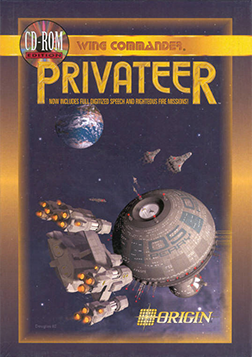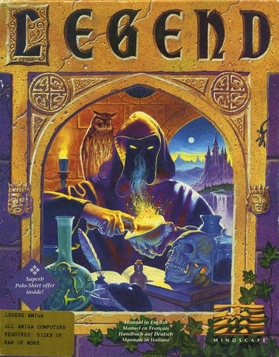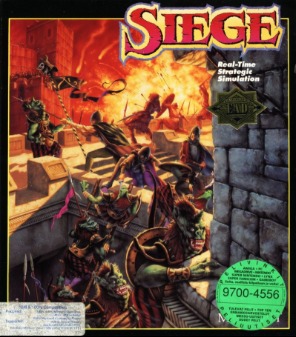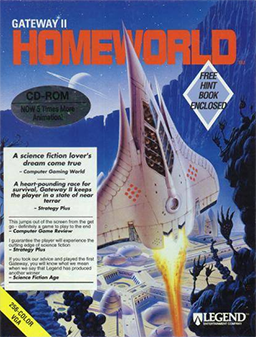
The Chaos Engine is a top-down run and gun video game developed by The Bitmap Brothers and published by Renegade Software in March 1993. The game is set in a steampunk Victorian age in which one or two players must battle the hostile creations of the eponymous Chaos Engine across four landscapes and ultimately defeat it and its deranged inventor.

Master of Orion is a turn-based, 4X science fiction strategy game in which the player leads one of ten races to dominate the galaxy through a combination of diplomacy and conquest while developing technology, exploring and colonizing star systems.

Alien Breed is a top down run and gun video game released in 1991 by Team17 for the Amiga and later in 1993 by MicroLeague for MS-DOS. The game is the first in the Alien Breed series.

UFO: Enemy Unknown, also known as X-COM: UFO Defense in North America and as X-COM: Enemy Unknown, is a 1994 science fiction strategy video game developed by Mythos Games and MicroProse. It was published by MicroProse for DOS and Amiga computers, the Amiga CD32 console, and the PlayStation. Originally planned by Julian Gollop as a sequel to Mythos Games' 1988 Laser Squad, the game mixes real-time management simulation with turn-based tactics. The player takes the role of commander of X-COM – an international paramilitary and scientific organization secretly defending Earth from an alien invasion. Through the game, the player is tasked with issuing orders to individual X-COM troops in a series of turn-based tactical missions. At strategic scale, the player directs the research and development of new technologies, builds and expands X-COM's bases, manages the organization's finances and personnel, and monitors and responds to UFO activity.

Space Hulk is a 1993 real-time tactical video game for MS-DOS, Amiga and PC-98. The game was based on Games Workshop's 1989 board game of the same name. Set in the fictional Warhammer 40,000 universe, the player directs squads of Space Marines, genetically enhanced armoured soldiers, in their missions to protect the human race from deadly aliens. Space Hulk was developed and published by Electronic Arts, with support from Games Workshop.

Strike Commander is a combat flight simulation video game designed by Chris Roberts and released by Origin Systems for the PC DOS in 1993. Its 3D graphics-engine used both gouraud shading and texture-mapping on both aircraft-models and terrain, an impressive feat at the time. Significant plot elements were presented through in-game cut-scene animations, a hallmark storytelling vehicle from Chris Robert's previous Wing Commander games. Strike Commander has been called "Privateer on Earth," due to the mercenary role-playing in the game.
In video games, artificial intelligence (AI) is used to generate responsive, adaptive or intelligent behaviors primarily in non-player characters (NPCs) similar to human-like intelligence. Artificial intelligence has been an integral part of video games since their inception in the 1950s. AI in video games is a distinct subfield and differs from academic AI. It serves to improve the game-player experience rather than machine learning or decision making. During the golden age of arcade video games the idea of AI opponents was largely popularized in the form of graduated difficulty levels, distinct movement patterns, and in-game events dependent on the player's input. Modern games often implement existing techniques such as pathfinding and decision trees to guide the actions of NPCs. AI is often used in mechanisms which are not immediately visible to the user, such as data mining and procedural-content generation.

Homeworld is a real-time strategy video game developed by Relic Entertainment and published by Sierra Studios on September 28, 1999, for Microsoft Windows. Set in space, the science fiction game follows the Kushan exiles of the planet Kharak after their home planet is destroyed by the Taiidan Empire in retaliation for developing hyperspace jump technology. The survivors journey with their spacecraft-constructing mothership to reclaim their ancient homeworld of Hiigara from the Taiidan, encountering a variety of pirates, mercenaries, traders, and rebels along the way. In each of the game's levels, the player gathers resources, builds a fleet, and uses it to destroy enemy ships and accomplish mission objectives. The player's fleet carries over between levels, and can travel in a fully three-dimensional space within each level rather than being limited to a two-dimensional plane.

The Magic Candle: Volume 1 is a role-playing video game designed by Ali Atabek and developed and published by Mindcraft in 1989.
UFO: Alien Invasion is a strategy video game in which the player fights aliens that are trying to take control of the Earth. The game is heavily influenced by the X-COM series, especially X-COM: UFO Defense.
The Star Fleet computer games are starship tactical combat simulations originally created by Dr. Trevor Sorensen in the late 1970s.

Wing Commander: Privateer is an adventure space trading and combat simulator computer game released by Origin Systems in September 1993. Privateer and its storyline is part of the Wing Commander series. The player takes the role of Grayson Burrows, a "privateer" who travels through the Gemini Sector, one of many sectors in the Wing Commander universe. Unlike Wing Commander, the player is no longer a navy pilot, but a freelancer who can choose to be a pirate, a merchant, a mercenary or any of the above in some combination. The player may follow the built-in plot but is free to adventure on his own, even after the plot has been completed.

Legend, also known as The Four Crystals of Trazere in the United States, is an isometric fantasy role-playing game released in 1992 for the Amiga, Atari ST, and DOS. It was developed by Pete James and Anthony Taglione for the then UK-based Mindscape, and published by The Software Toolworks. In the game, the player controls four adventurers on a quest to save the land of Trazere from an ancient, re-awakening evil. In 1993, Mindscape released a sequel, Worlds of Legend: Son of the Empire. The copyrights for both "Legend" and "Worlds of Legend" are currently owned by Ubisoft, who bought them from Mattel Interactive with the rest of the Mindscape library in 2001.

MechWarrior 2: Mercenaries is a video game released in September 1996 as a stand-alone expansion to MechWarrior 2: 31st Century Combat and the last BattleTech game made by Activision. In this game, the player takes control of an Inner Sphere mercenary squad, with control over finances and free choice of missions.

Close Combat is a 1996 real-time computer wargame developed by Atomic Games and published by Microsoft. Set during World War II, it simulates the conflict between the United States' 29th Infantry Division and Germany's 352nd Infantry Division after the Invasion of Normandy. The player controls an artificially intelligent army whose behavior is dictated by psychological models: each soldier makes decisions based on the circumstances of the battlefield and can disobey the player's orders.
Killzone is a series of first-person shooter video games for Sony Interactive Entertainment's (SIE) video game consoles. The main series and the PlayStation Portable (PSP) installment were developed by Guerrilla Games, a subsidiary of SIE, and the PlayStation Vita installment was developed by Guerrilla Cambridge. Killzone consists of six games, beginning on the PlayStation 2 in November 2004 with Killzone, and continued on the PlayStation Portable in October 2006 with Killzone: Liberation. Killzone 2 was released for the PlayStation 3 in February 2009, and Killzone 3 was released in February 2011, also for the PlayStation 3. Killzone: Mercenary was released for the PlayStation Vita in September 2013, followed by Killzone: Shadow Fall, a launch title for the PlayStation 4, in November 2013.

Siege is a video game released by Mindcraft in 1992 for MS-DOS. An expansion pack, Dogs of War, was released. It added multiplayer, six new castles, and 16 new units to the game. A sequel, Ambush at Sorinor, was released in 1993.

Walls of Rome is a video game developed by Mindcraft in 1993 for DOS. It is set in the Roman Empire and focuses on siege warfare.

Gateway II: Homeworld is a 1993 interactive fiction video game developed and published by Legend Entertainment. The sequel to Gateway (1992), it is set in Frederik Pohl's Heechee universe.

Ambush at Sorinor is a video game released by Mindcraft in 1993 for MS-DOS. It is a sequel to Siege from 1992. It is made with the same game engine as Siege. It takes place in the same universe as The Magic Candle.
















